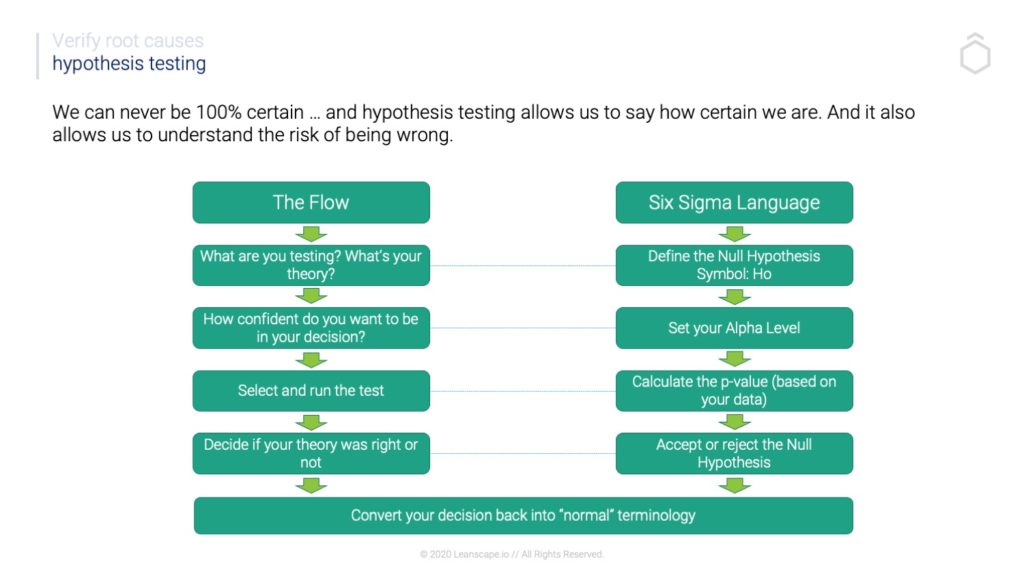Hypothesis Testing provides a systematic way of testing assumptions and predictions against empirical evidence, enabling leaders in their respective fields to make well-informed decisions backed by facts.
An Introduction to Hypothesis Testing
Project managers are always looking for ways to improve their project management process. One tool that can be used is hypothesis testing. Hypothesis testing is a statistical tool used to make decisions about a population based on a sample.
The null hypothesis is the statement that there is no difference between the population and the sample. The alternative hypothesis is the statement that there is a difference between the population and the sample. The goal of hypothesis testing is to determine which of these two hypotheses is true.
So firstly, let’s return to the idea of the confidence interval. Confidence intervals showed us that we can never take a statistic at face value anymore, as there is always some potential for error. Why we can never be certain, we may be able to be confident enough to make a decision. The hypothesis test is what helps us make a decision.
Types of Hypothesis Tests
There are two types of tests: parametric and nonparametric.
Parametric tests make assumptions about the population, such as data distribution. Nonparametric tests do not make assumptions about the population.
One-tailed vs two-tailed tests
One-tailed tests and two-tailed tests are another distinctions in hypothesis testing. A one-tailed test is used when there is a directional hypothesis, such as “the average score on this test will be higher than 80%.” A two-tailed test is used when there is no directional hypothesis, such as “the average score on this test will be different from 80%.”
Choosing a Type of Test
When choosing a type of test, the first step is to determine if the data are parametric or nonparametric. This can be done by looking at the distribution of data. If the data are Normally distributed, then parametric tests can be used. If the data are not Normally distributed, then nonparametric tests should be used.
The second step is to determine if the hypothesis is directional or not. If the hypothesis is directional, then a one-tailed test should be used. If the hypothesis is not directional, then a two-tailed test should be used.
What are the steps you must follow to run a hypothesis test:
There are four steps involved in hypothesis testing for a difference in means:
1) stating the null and alternative hypotheses,
2) selecting a level of significance,
3) calculating the test statistic, and
4) making a decision about the null hypothesis.

The null hypothesis is always stated in terms of the population parameter, while the alternative hypothesis is stated in terms of the sample statistic. The level of significance is the probability of making a Type I error; this is usually set at 0.05. The test statistic is used to calculate the p-value; this is the probability of observing a sample statistic if the null hypothesis is true. If the p-value is less than or equal to the significance level, then we reject the null hypothesis in favour of the alternative hypothesis.
Let’s work through an example.
Suppose we are interested in whether there is a difference in average monthly income between men and women.
We can state our hypotheses as follows:
H0: μ1 – μ2 = 0 (There is no difference in average monthly income between men and women)
H1: μ1 – μ2 ≠ 0 (There is a difference in average monthly income between men and women)
We will set our significance level at 0.05 and use a two-tailed test since we do not have any directional predictions.
Our test statistic will be t = (x̄1 – x̄2)/s₌₁₂√(1/n₁ + 1/n₂). (but don’t worry about how this is calculated right now :))
After doing some calculations, we find that t = 2.45 with n₁ = n₂ = 10. (There is a table we will show you that allows you to look these figures up).
The corresponding p-value is 0.026, which is less than 0.05.
Therefore, we reject the null hypothesis and conclude that there is evidence of a statistically significant difference in average monthly income between men and women.
Conclusion:
Hypothesis testing can be a helpful tool for project managers who want to improve their project management process. Hypothesis testing can help you decide about a population based on a sample. There are two types of tests: parametric and nonparametric. Parametric tests make assumptions about the population, while nonparametric tests do not make assumptions about the population.
One-tailed tests and two-tailed tests are other distinctions in hypothesis testing. A one-tailed test is used when there is a directional hypothesis, while a two-tailed test is used when there is no directional hypothesis. When choosing a type of test, the first step is to determine if the data are parametric or nonparametric. The second step is to determine if the hypothesis is directional or not.
To get learn how to use the Hypothesis Test and other Lean Six Sigma Tools, join our next Lean Six Sigma Green Belt Course.






